Table of Contents
Introduction
Mixed Reality Statistics: Mixed Reality (MR) seamlessly integrates the real world with digital elements, creating environments where physical and digital objects coexist and interact in real-time.
It stands between the fully immersive experiences of Virtual Reality (VR) and the simple digital overlays of Augmented Reality (AR), leveraging technologies such as sensors, advanced computing, and head-mounted displays to foster unique interactions.
MR finds applications in diverse sectors, including education, healthcare, manufacturing, retail, and entertainment, offering immersive learning experiences, aiding in complex surgical procedures, enhancing product design and visualization, improving customer engagement, and creating novel entertainment options.
As MR technology advances, it faces challenges like hardware miniaturization and privacy concerns. Yet, its evolving capabilities continue to shape a future where digital and physical realms merge more seamlessly, transforming everyday experiences.
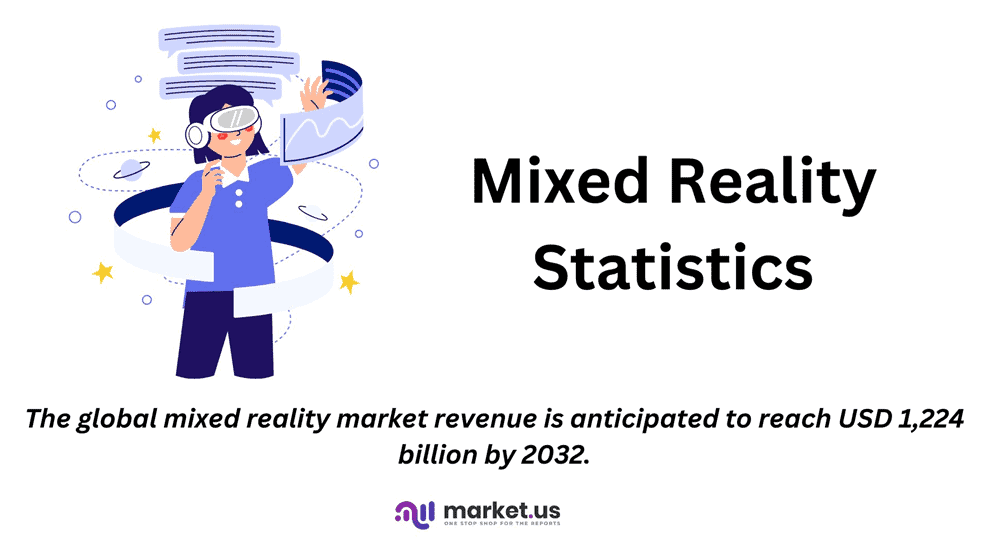
Editor’s Choice
- The global Mixed Reality (MR) market revenue is expected to reach USD 1,224.0 billion by 2032.
- The Mixed Reality (MR) market demonstrates a diverse application spread, with Automotive & Aerospace leading the way, holding a 27% market share.
- In 2020, among the user base of the augmented and virtual reality (VR) software market, video games led the charge with a substantial user base of 70 million, a figure projected to surge to 215 million by 2025.
- In the realm of virtual reality (VR), the most captivating aspect, as perceived by users, is the feeling of entering another world, with 47% of responses highlighting this immersive experience as the pinnacle of VR’s allure.
- As of October 2022, gaming emerged as the most popular application in the U.S., with 37% of respondents indicating their interest, highlighting VR’s significant impact on enhancing the gaming experience.
- The consumer segment leads the investment in AR and VR, with spending reaching USD 6.36 billion, underscoring the significant interest in AR and VR for personal entertainment, gaming, and shopping experiences.
- User experiences, highlighted by issues such as bulky hardware and technical glitches, are a major concern, affecting AR and VR at rates of 32% and 19%, respectively.
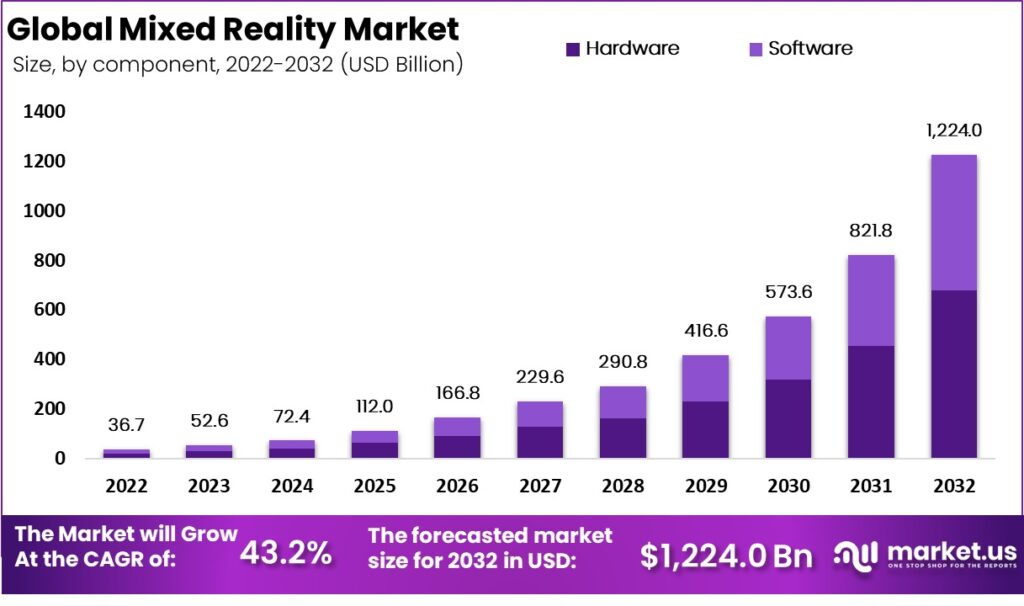
Global Mixed Reality Market Overview and Statistics
Global Mixed Reality Market Size Statistics
- The global Mixed Reality (MR) market has demonstrated remarkable growth over a decade at a CAGR of 43.2%, starting with a revenue of USD 36.7 billion in 2022.
- By 2023, this figure rose significantly to USD 52.6 billion, indicating the accelerating interest and investment in MR technologies.
- The market continued to expand robustly, reaching USD 72.4 billion in 2024.
- With an impressive surge, revenues were projected to climb to USD 112.0 billion by 2025, followed by a steep increase to USD 166.8 billion in 2026.
- The upward trend persisted, with the market size expanding to USD 229.6 billion in 2027 and then to USD 290.8 billion in 2028.
- A notable jump was observed in 2029, with revenues soaring to USD 416.6 billion, underscoring the rapid adoption and integration of MR across various sectors.
- By 2030, the market was expected to reach USD 573.6 billion, further escalating to USD 821.8 billion in 2031.
- The growth trajectory culminated in an impressive market revenue of USD 1,224.0 billion by 2032, highlighting the substantial impact and potential of Mixed Reality technology statistics in transforming industries and user experiences worldwide.
(Source: Market.us)
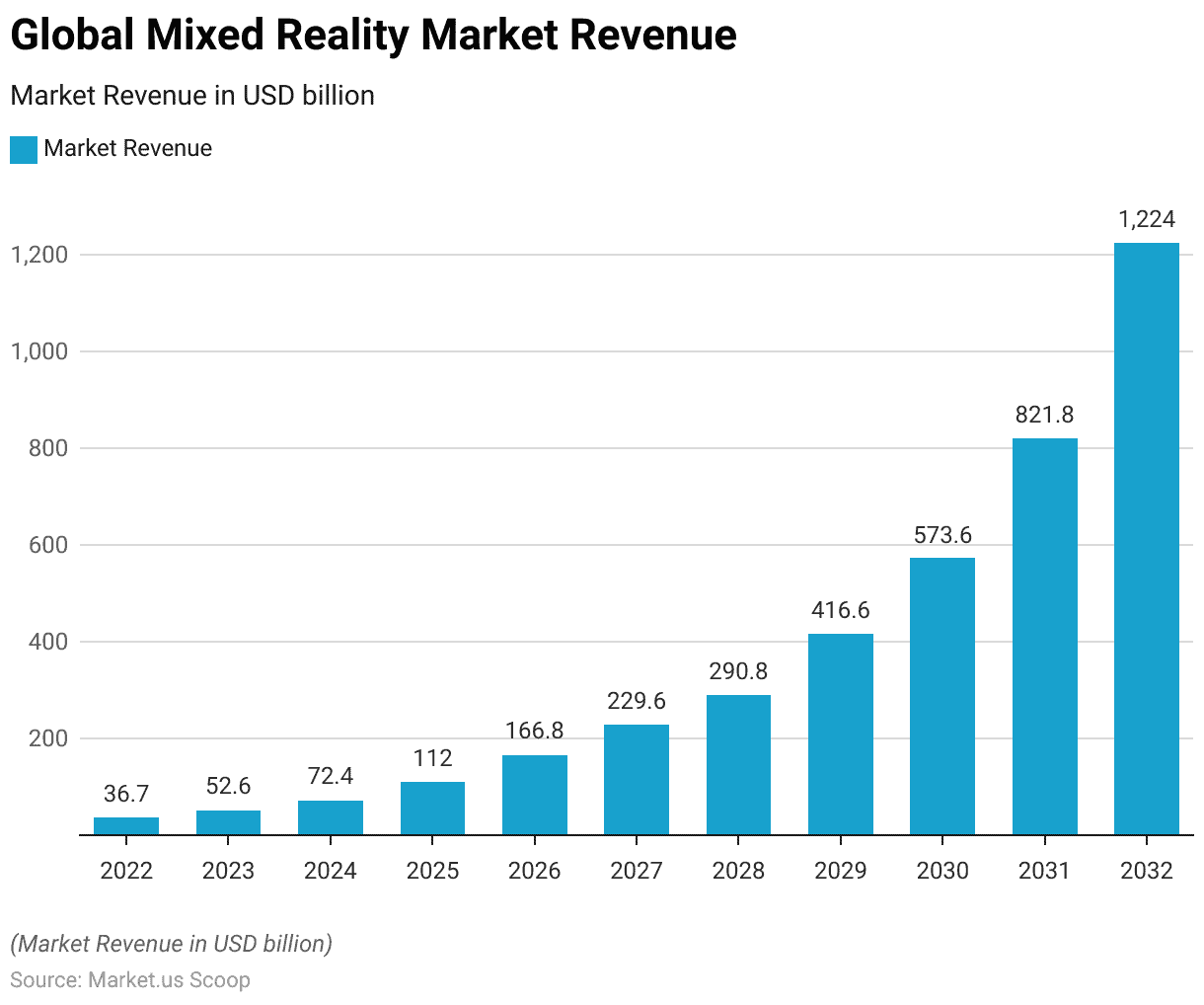
Mixed Reality Market Size – By Component Statistics
- The global Mixed Reality (MR) market has seen remarkable growth over the past decade, driven by significant contributions from both hardware and software components.
- Starting in 2022 with a market revenue of USD 36.7 billion, split between USD 28.81 billion from hardware and USD 7.89 billion from software, the market has consistently expanded.
- By 2023, it reached USD 52.6 billion and continued its upward trajectory, reaching USD 72.4 billion in 2024.
- This growth momentum was sustained, with market revenues hitting USD 112.0 billion in 2025 and then leaping to USD 166.8 billion in 2026.
- The market size further escalated each year, reaching USD 290.8 billion by 2028, USD 416.6 billion by 2029, and an impressive USD 573.6 billion by 2030.
- The trend continued upward, culminating in market sizes of USD 821.8 billion and USD 1,224.0 billion in 2031 and 2032, respectively.
- Throughout this period, hardware consistently contributed the majority of the revenue, underscoring its crucial role alongside software in driving the MR market’s dynamic evolution.
(Source: Market.us)
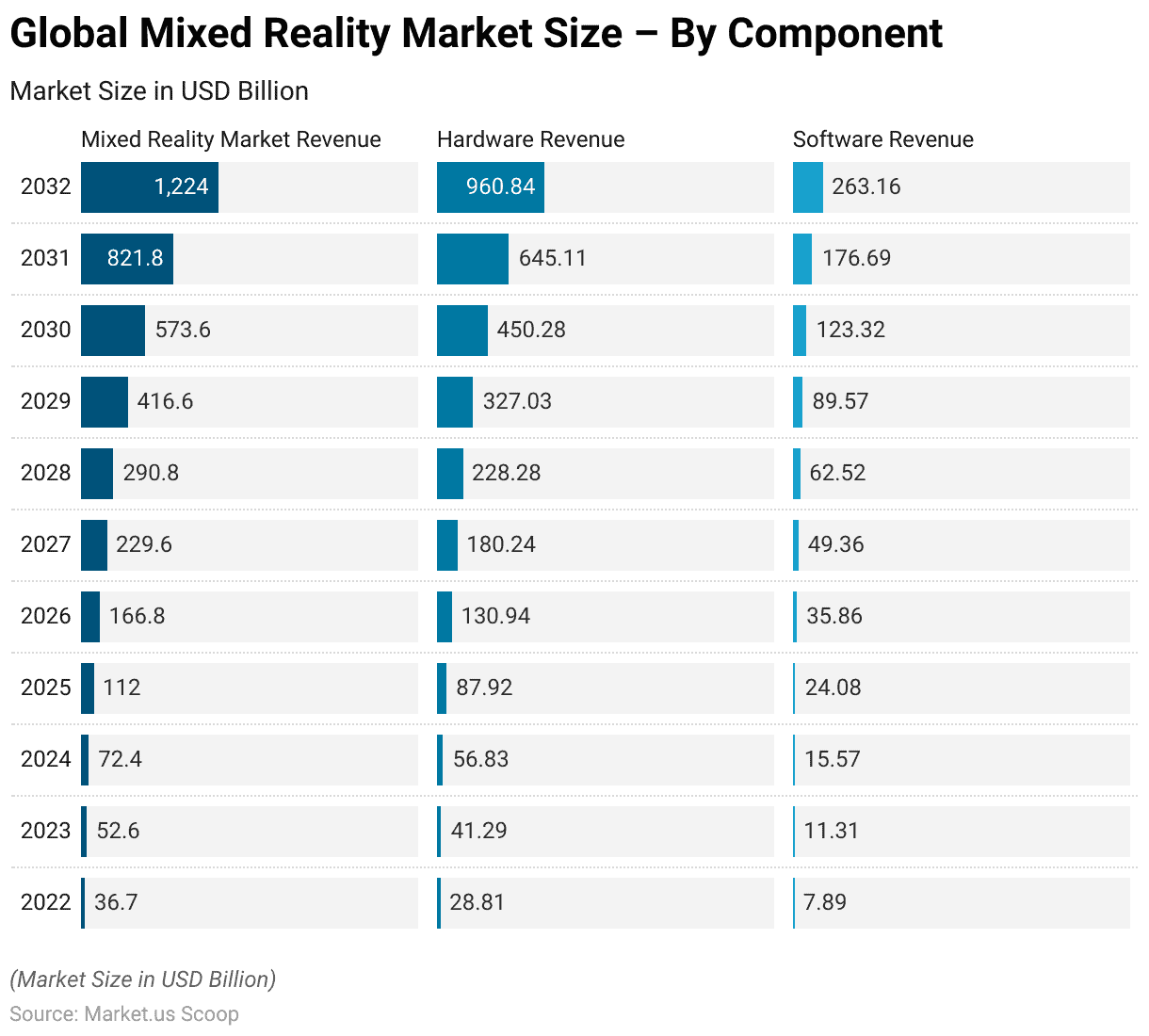
Mixed Reality Market Share – By Application Statistics
- The Mixed Reality (MR) market demonstrates a diverse application spread, with Automotive & Aerospace leading the way, holding a 27% market share.
- This is closely followed by the Healthcare sector, which commands a 23% share, highlighting MR’s significant impact on improving diagnostics, patient care, and surgical procedures.
- Entertainment, along with E-commerce & Retail, each contribute 17% to the market, reflecting MR’s role in transforming consumer experiences, from immersive gaming to innovative shopping experiences.
- Other Applications, encompassing sectors such as education, manufacturing, and real estate, account for the remaining 16%, indicating MR’s wide-reaching potential across various industries.
- This distribution showcases the versatility of MR technology and its capacity to revolutionize multiple facets of the global economy.
(Source: Market.us)
Take advantage of our unbeatable offer - buy now!

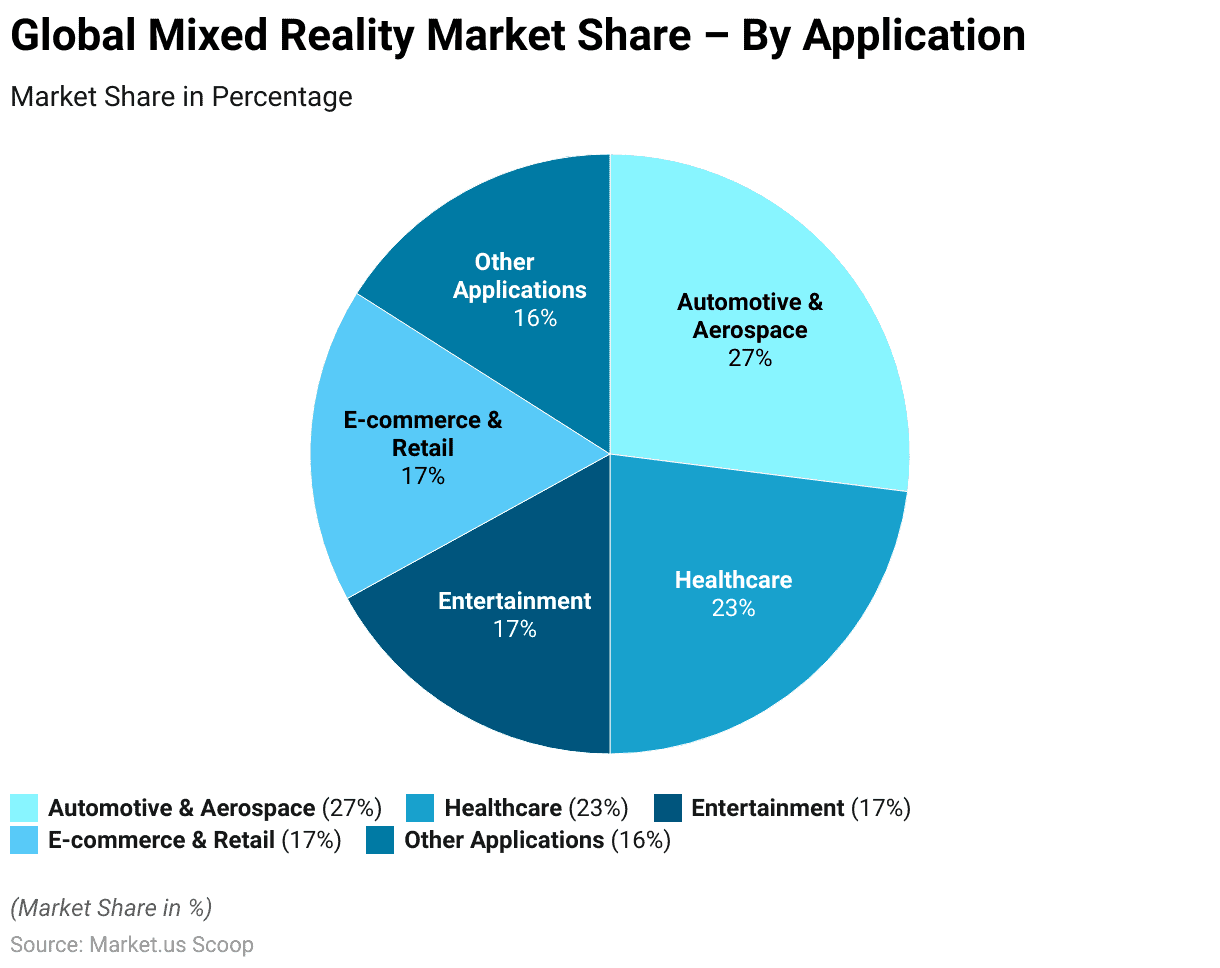
Mixed Reality Statistics By User Base of the AR and VR Software Market – By Segment
- In 2020, the user base of the augmented and virtual reality (VR) software market worldwide exhibited a varied distribution across different segments.
- Video games led the charge with a substantial user base of 70 million, a figure projected to surge to 215 million by 2025.
- Live events followed, boasting 28 million users in 2020, with expectations to rise to 95 million in five years.
- Video entertainment also showed strong engagement with 24 million users, which is anticipated to grow to 79 million by 2025.
- Retail and education sectors demonstrated promising growth, starting from 9.5 million and 7 million users, respectively, in 2020, and are forecasted to expand to 31.5 million and 15 million users by 2025.
- Healthcare, engineering, and real estate segments, though starting from smaller bases—0.8 million, 1 million, and 0.2 million users, respectively, in 2020—were also expected to witness growth, with healthcare reaching 3.4 million, engineering 3.2 million, and real estate slightly growing to 0.3 million users by 2025.
- This forecast underscores the increasing adoption and diverse applications of AR and VR technologies across various sectors, highlighting a significant expansion of their user base over the five years.
(Source: Statista)
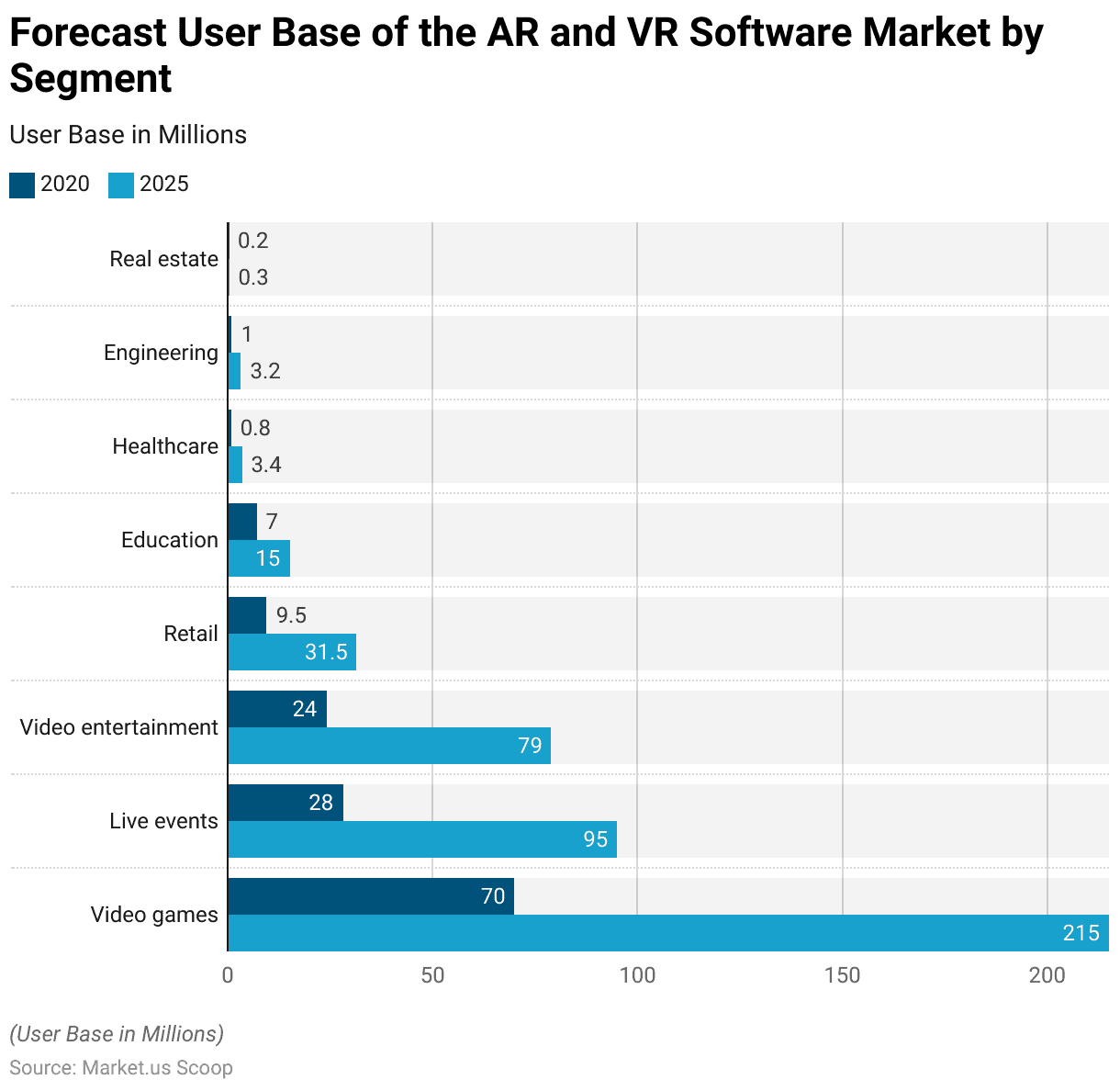
Interest in Virtual Reality (VR)
User Perception
- In the realm of virtual reality (VR), the most captivating aspect, as perceived by users, is the feeling of entering another world, with 47% of responses highlighting this immersive experience as the pinnacle of VR’s allure.
- This is followed by an appreciation for the technology itself, which garnered 36% of the feedback, underscoring the marvel at the sophisticated tech that makes such immersive experiences possible.
- Trying something completely new also stood out, with 31% of respondents excited by the novelty VR introduces.
- An intense gaming experience was significant for 26% of the participants, indicating VR’s power to transform gaming into a deeply engaging activity.
- The possibility of being ‘part of the movie’ appealed to 21%, showcasing VR’s potential to revolutionize entertainment by placing viewers inside the narrative.
- Additionally, 16% of the respondents noted new possibilities for communication, highlighting VR’s capacity to innovate interactions.
- Interestingly, 16% of individuals were unsure, indicating either a broad interest in all aspects of VR or a lack of familiarity with the technology.
- This diversity in responses underscores the multifaceted appeal of VR, from its immersive experiences to its groundbreaking technological foundations.
(Source: Statista)
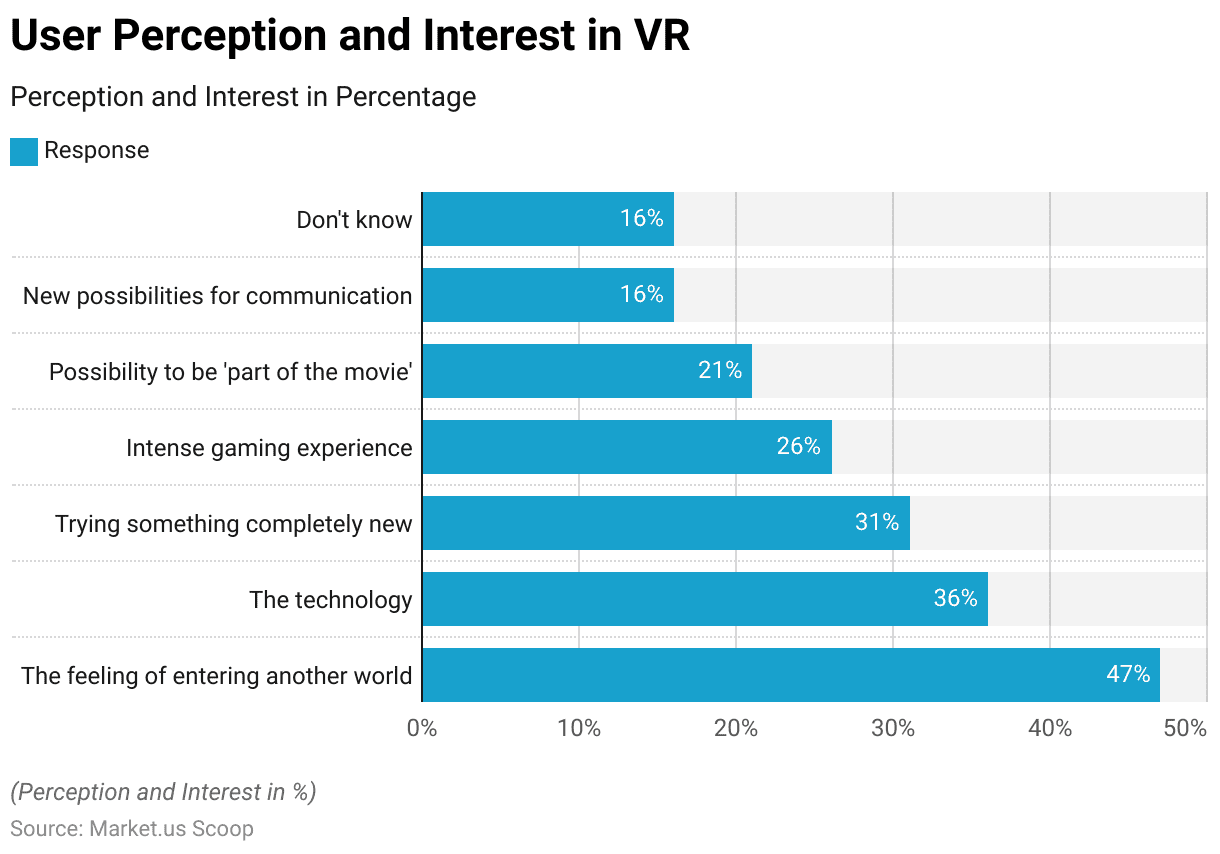
Interest in VR – By Use Case
- As of October 2022, interest in virtual reality (VR) within the United States showcased a diverse array of use cases, reflecting the technology’s broad appeal across different sectors.
- Gaming emerged as the most popular application, with 37% of respondents indicating their interest, highlighting VR’s significant impact on enhancing the gaming experience.
- Travel followed, capturing the imagination of 12% of those surveyed, suggesting a growing curiosity about exploring distant locations virtually.
- Music, watching movies and TV shows, and immersive environments each drew the attention of 9% of respondents, indicating a keen interest in using VR for entertainment beyond traditional gaming.
- Training and education, along with imaginary environments, both garnered 8% of the interest, pointing towards VR’s potential in educational settings and creative exploration.
- History was of interest to 7% of respondents, suggesting a niche yet noteworthy desire to use VR for educational enrichment and exploring past events in an immersive manner.
- Interestingly, only 1% of respondents cited making content better as their primary interest in VR, indicating that while content enhancement is recognized, it may not be the primary driver of interest in VR technologies.
- This diversity in use cases underscores VR’s multifaceted appeal, from entertainment and education to creative and historical exploration.
(Source: Statista)
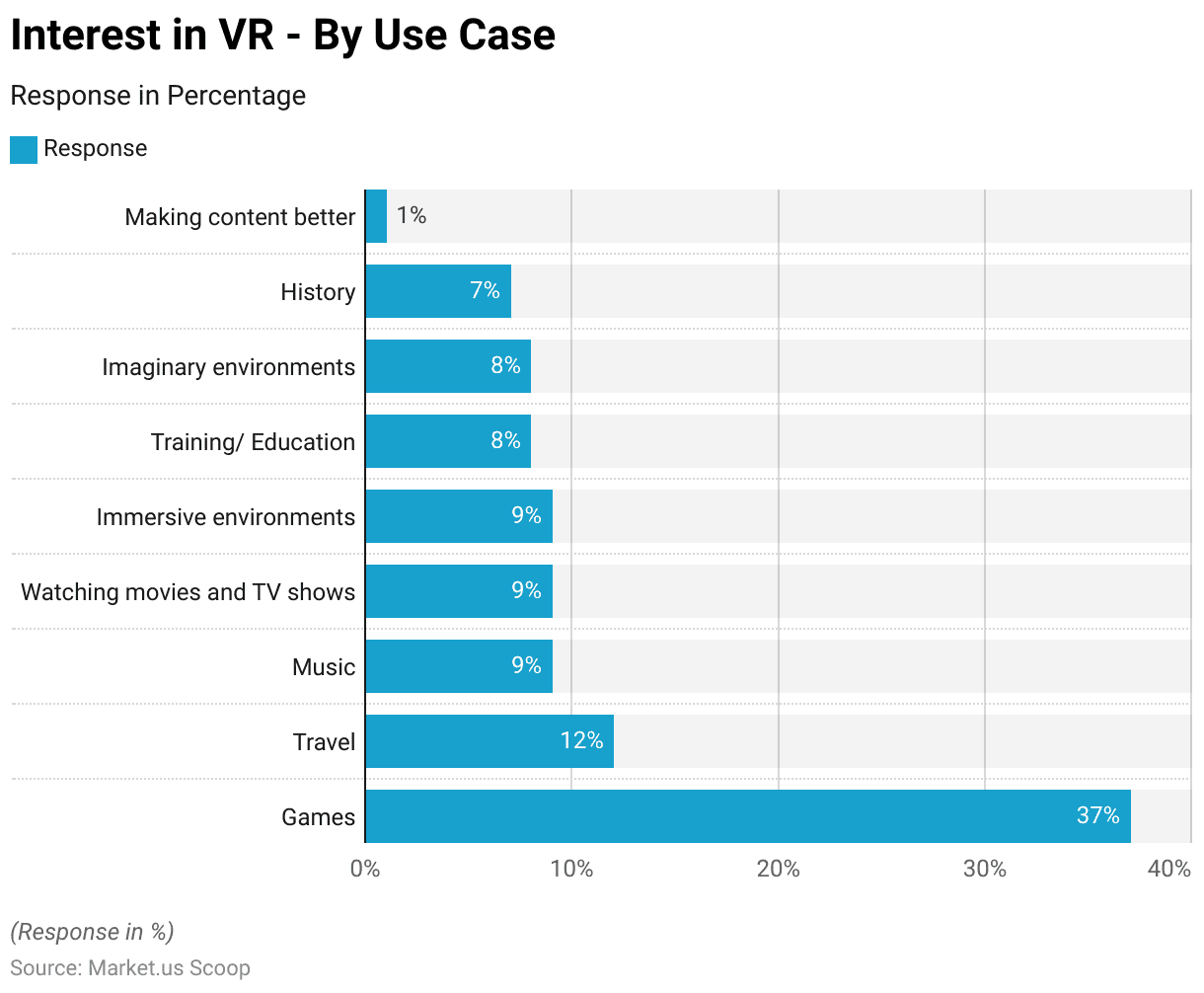
Investment and Spending in AR and VR
- Investment and spending in Augmented Reality (AR) and Virtual Reality (VR) technologies are segmented across various industries, reflecting their wide-ranging applications and varying levels of adoption.
- The consumer segment leads the investment, with spending reaching USD 6.36 billion, underscoring the significant interest in AR and VR for personal entertainment, gaming, and shopping experiences.
- The distribution and services sector follows with an investment of USD 1.9 billion, indicating the importance of AR and VR in enhancing customer service, logistics, and retail experiences.
- Manufacturing and resources are not far behind, with spending of USD 1.66 billion showcasing the adoption of these technologies for training, design, and operational efficiencies.
- The public sector also recognizes the value of AR and VR, investing USD 1.52 billion in applications such as education, training, and healthcare.
- Infrastructure investments stand at USD 0.38 billion, pointing to the nascent but growing interest in AR and VR for construction, utilities, and urban planning.
- Lastly, the ‘Others’ category, encompassing miscellaneous sectors, accounts for USD 0.19 billion in spending, highlighting the emerging interest across various fields.
- This distribution of investment across sectors illustrates the broad potential of AR and VR technologies to transform both consumer experiences and industry operations.
(Source: Statista)
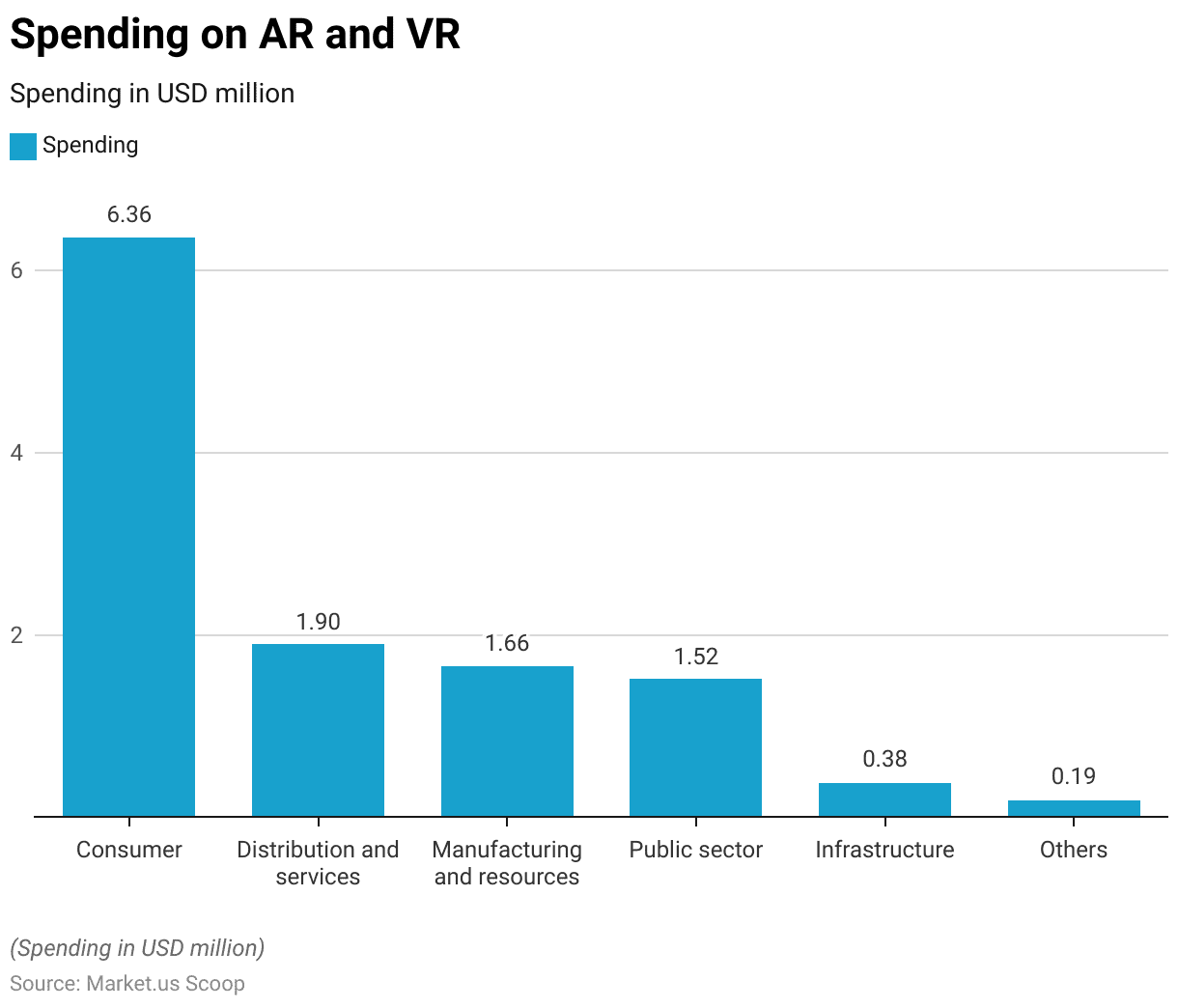
Challenges to the Adoption of AR and VR
- Barriers to the mass adoption of Augmented Reality (AR) and Virtual Reality (VR) technologies reveal significant challenges, albeit with varying impacts across the two domains.
- User experiences, highlighted by issues such as bulky hardware and technical glitches, are a major concern, affecting AR and VR at rates of 32% and 19%, respectively. This indicates a greater perceived barrier in AR related to hardware and usability.
- Content offerings present another substantial hurdle, with VR facing a higher challenge (27%) compared to AR (18%), pointing towards a demand for higher quality and more varied VR content.
- Consumer and business reluctance to embrace these technologies is equally noteworthy, cited by 15% for AR and 19% for VR, suggesting a shared apprehension toward adopting these novel technologies.
- Regulation and legal risks also pose barriers, though more so for AR (14%) than VR (12%), highlighting the potential legal complexities associated with augmented environments.
- Financing and investment concerns are raised, with AR (11%) facing slightly more challenges than VR (9%), indicating differing levels of investment confidence.
- The cost to consumers is more pronounced in VR (11%) compared to AR (7%), suggesting that the price of VR devices and experiences is a more significant barrier.
- Lastly, government oversight is considered the least barrier, affecting AR and VR at 4% and 3%, respectively, implying minimal concern over regulatory intervention.
- These barriers illustrate the complex landscape of challenges that AR and VR must navigate to achieve mass adoption, with each technology facing its unique set of hurdles.
(Source: Art Labs)

Recent Developments
Acquisitions and Mergers:
- TechGiant acquired MixedReality Solutions for $800 million, solidifying its position in the mixed-reality market and expanding its portfolio of immersive technology solutions.
- XR Innovations merged with VirtualTech, forming a strategic partnership to drive innovation in mixed reality hardware and software development, with combined expertise aimed at advancing immersive experiences.
New Product Launches:
- MixedTech unveiled a next-generation mixed-reality headset with enhanced display resolution and spatial mapping capabilities, aiming for 500,000 units sold within the first year.
- RealityPlus launched a mixed reality content creation platform for developers and content creators, providing tools for immersive storytelling and interactive experiences, targeting 1 million users within six months.
Funding Rounds:
- MixedRealityTech secured $100 million in Series A funding led by Venture Capital Firm XYZ to scale up their mixed reality platform and invest in content partnerships, aiming for a 50% increase in user engagement within the next year.
- ImmersiveTech received $50 million in seed funding from Investment Group ABC to develop innovative mixed reality applications and establish collaborations with industry partners, targeting a 40% growth in revenue over the next fiscal year.
Industry Adoption Trends:
- Mixed reality applications in healthcare experienced significant growth, with a 40% increase in adoption for medical training, patient education, and surgical planning.
- The manufacturing and automotive sectors witnessed a surge in mixed reality implementation, with a 50% increase in adoption for product design, assembly line optimization, and virtual prototyping.
Regulatory Landscape:
- Regulatory agencies implemented guidelines for mixed reality safety and privacy, ensuring adherence to quality standards and user data protection in immersive technology solutions.
Investment in Research and Development:
- Technology companies and research institutions allocated substantial resources to research and development in mixed reality technology, with an estimated $4 billion invested globally in immersive advancements and market expansion initiatives.
Conclusion
Mixed Reality Statistics – Mixed Reality (MR) emerges as a key technology bridging the real and digital realms, promising transformative, immersive experiences across multiple industries.
Its rapid market growth and expanding user base underscore its potential to revolutionize sectors from entertainment to healthcare and education.
However, the journey towards widespread MR adoption faces hurdles such as user experience issues, content scarcity, and regulatory challenges.
Addressing these concerns, along with mitigating consumer and business reluctance and financial obstacles, is crucial for MR’s success.
Innovations aimed at improving user interactions, broadening content, and navigating legalities are key to unlocking MR’s full capabilities.
As we advance, MR is set to significantly alter our interaction with technology, blurring the lines between physical and virtual spaces and heralding a future rich with immersive opportunities.
FAQs
Mixed Reality (MR) is a technology that blends real-world and digital elements, creating environments where physical and digital objects coexist and interact in real time.
It merges aspects of both Augmented Reality (AR) and Virtual Reality (VR), offering a spectrum of immersive experiences that can range from the real world with digital overlays to fully immersive virtual scenarios.
Mixed Reality works by combining advanced computing, sensor technology, and display systems to create interactive virtual experiences overlaid on the real world.
Devices like MR headsets use cameras, sensors, and software algorithms to map the user’s physical environment and position virtual objects within it, allowing for real-time interaction between the user and the digital content.
Mixed reality is often seen as encompassing a broader spectrum of experiences that include elements of both AR and VR.
While AR overlays digital information onto the real world without allowing for physical interaction, and VR creates a completely virtual environment isolated from the real world, MR blends these two, creating interactive environments that integrate real-world and virtual elements.
The future of Mixed Reality is likely to see continued technological advancements leading to lighter, more affordable devices, richer and more engaging content, and broader applications across more sectors.
As these developments address current limitations, MR has the potential to become an integral part of daily life and work, transforming how we interact with digital information and the world around us.
Discuss your needs with our analyst
Please share your requirements with more details so our analyst can check if they can solve your problem(s)



